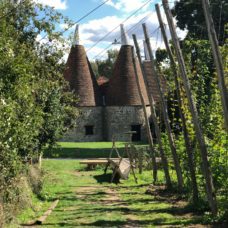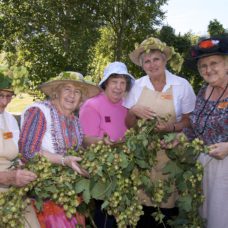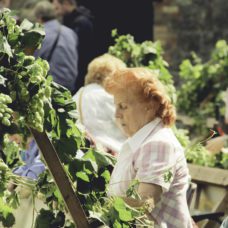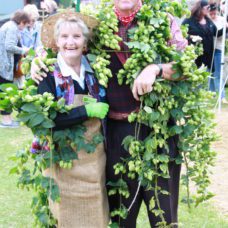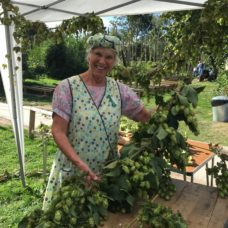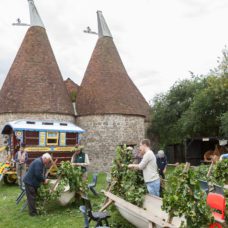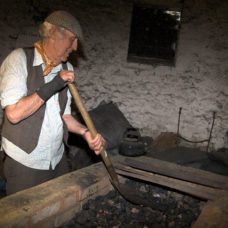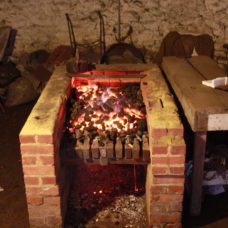HOPPING AT KENT LIFE: GETTING FIRED UP FOR HARVEST TIME
There’s a chilly nip in the air and the sun fades faster as the night steals in earlier, which means it’s time to fire up the coals of the last working Oast House in Britain for our annual hop harvest and 33rd Hops n Harvest celebration.
Traditionally, late August and early September is the time of year when, in bygone times. whole families of Londoners would gather together and travel to the Garden of England, unlock their hopper hut and spend their annual holidays, harvesting the county’s famous hop crop and sleeping on beds of straw. Take a peek inside our re-constructed hoppers’ huts and see for yourself!
If you wander into the Kent Life hop garden today and gently rub one of the pale green mature hop cones you can breathe in the heady, bitter, green aroma, just days before it is plucked from its bine.
It’s a perfect example of a typical Kentish hop garden, the like of which have flourished in the county since the 1500s as a result of the rich fertile soil, sheltered sunny sites and woodland. It features Goldings and Fuggles hop varieties grown using a complicated system of poles and wires, up which the hop bines are ‘twiddled’ to allow them to grow to their full height and still be pulled down at harvest time.
Our festival offers everyone the chance to join the harvest and collect hops in the hop pokes, loosely woven sacks that can hold 8-10 bushels of hops. From here, they are taken to the Oast house, just 20 metres away, where the coal fire in the kiln will have been lit on Saturday morning in anticipation of the start of the festival. The hops are then laid out to be dried on a specially constructed floor above the kiln, taking care that they are not exposed to temperatures above 65 degrees centigrade (150 degrees farenheit) – a scorched hop flavour in your beer would not go down well! This takes around eight hours and then the hot dry hops are spread out on the floor of the cooling room. Finally, they are packed into sacks or ‘pockets’ as they are traditionally called.
Phew! After all that hard work, it’s surely time to enjoy the fruits of our labour and head up to the top field to quench our thirst and sample some of Kent’s finest ales!
After the weekend’s festivities, when the hop pockets are full and the coal fire is extinguished on Monday morning, the hop garden will remain tranquil until next March when stringing takes place ready for the hops to grow through to September again.
If you’re coming to the festival, look out for John and Tim, our resident hop experts, who, as volunteer Friends of Kent Life, tend to the hop garden and preside over the Oast House throughout this special celebration weekend. What they don’t know about hops and hopping in Kent probably isn’t worth knowing – and if you’re lucky they might be persuaded to share a story or two!
Here’s our insider guide to our magnificent Oast House:
- When you enter and exit through the Gift Shop, you’re actually walking through a traditional Oast House. The square part, housing the shop itself, is an earlier square shaped Oast, which ceased to exist as circular Oasts took their place in favour of the improved even spread of heat provided by eliminating corners!
- Next time you walk through the Gift Shop look for the line on the floor running the length of the shop, which shows where the original stalls were. These were used for storing the farm’s barley crop in giant nets fixed inside each of the stalls.
- The current building had to be re-built in 1951 after a fire – thought to have been started by an individual sheltering in the upper part of the Oast – destroyed it.
- There is no evidence or living memory of hop gardens on the Sandling Farm, so it’s not clear why an Oast House originally existed on this spot. The Kent Life hop garden only came into existence in the late 20th century
- EXPLORE Find out all about the amazing parts of our site that make Kent Life such a fun day out!
- PLAN YOUR VISIT Opening times, prices, how to get here, and annual memberships.
- EVENTS We've got events for all, all year round- from our annual hop festival to Christmas and Fireworks celebrations!
- ABOUT US We've been going quite some time - as has Kent! Check out our story here.

